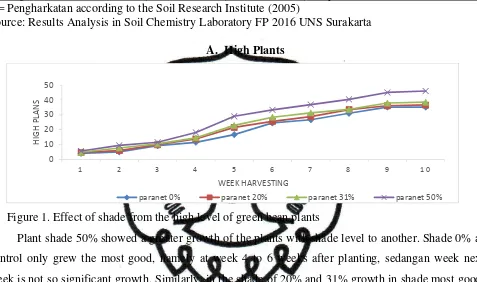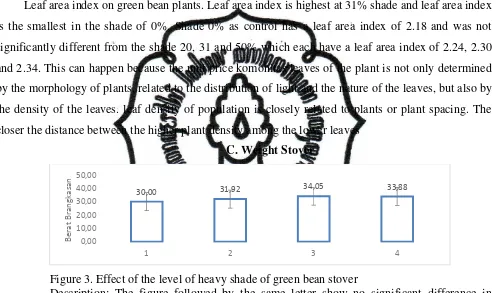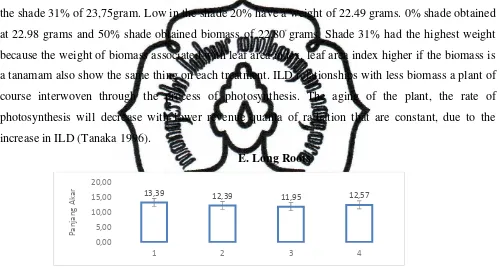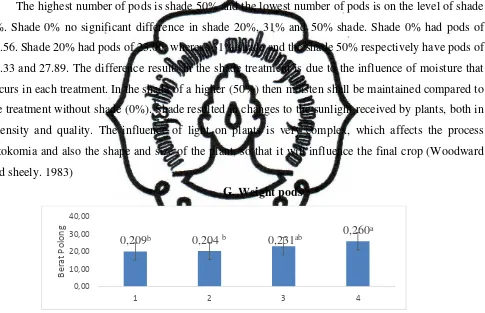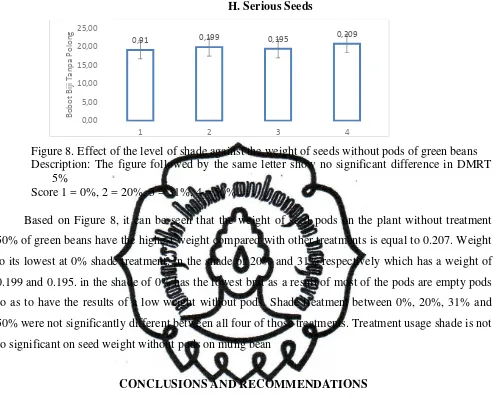commit to user
TANGGAPAN KACCANG HIJAU PADA BERBAGAI TINGAT NAUNGAN1)
Liza Herdyana1), Supriyono2), Budiastuti2)
1) Mahasiswa Program Studi Agroteknologi Fakultas Pertanian Universitas Sebelas Maret
Surakarta
2) Dosen Program Studi Agroteknologi Fakultas Pertanian Universitas Sebelas Maret Surakarta
Kontak Penulis :anli.liza@gmail.com
ABSTRACT
Production of mungbean plants less food sufficiency in the land, mungbean technology was developed in order to obtain optimal results. Mungbeans do not require a lot of sunlight so it can use the technology planting shade. This research aims to study the response of mungbeans at different levels of shade on growth and yield. This research aims to study the response of mungbeans at different levels of shade on growth and yield. The research was conducted in October through December 2015 in Jumantono, Karanganyar, Central Java using a Randomized Completely Block Design (RCBD) consists of a single factor shade treatment with 5 levels ie 0, 20, 31 and 50%. Data were analyzed using analysis of variance and if there is a significant difference continued with Duncan Multiple (Duncan Multiple Range Test) level of 5%. The results showed with 50% shade can increase plant height, leaf number, leaf area index, biomass weight, weight of pods and seed weight
Keyword : Mungbean, Drought Stress, Growth, Yield
INTRODUCTION
Mungbean is a potential commodity has advantages both in terms of agronomist nor economical. It
has easy way, can be planted in soil that is less lush, more resistant to drought, can be harvested aged
60 days, and the selling price is relatively high and stable. Indonesia is the largest producer of green
beans to four in the world after India, Thailand, and China, with a vast harvest of about 300,000
ha/year. Mungbean in Indonesia ranks third the most important food crop after soybeans, legumes and
peanuts. Because of its great importance, the need for mungbean green peas ever on the rise. With
increasing needs for mungbeans in Indonesia, of course, increase in quantity is very expected.
Benefits of the mungbean are needed, especially in the food industry. The need for mungbean in
Indonesia itself has not fulfilled so that Indonesia needs to import mungbean from several countries
including Myanmar, Ethiopia, Thailand, Australia, and Brazil. Throughout January to March 2014,
imports into Indonesia reached 18.64 thousand tons. Indonesia to import mungbean from several
countries increased quite dramatically in March 2014 compared to the previous month. In February,
imports of mungbeans totaled 6.27 thousand tons. The rapid increase became 13.96 thousand tons in
March. Total imports of mungbean during the first 3 months of 2014 recorded 23.45 thousand tons.
The high level of imports of mungbean illustrates the low production of green beans that exist in
Indonesia. Green bean production management or planting low because less than optimal
Problems encountered in the development of mung bean is still low production reached farmers.
commit to user
Production of mung bean that are less meet these needs, the green bean planting technology was
developed in order to obtain optimal results. Plant mung bean do not require a lot of sunlight and
therefore planting mung bean can use shade. Use of shade can keep the intensity of sunlight. This
research was conducted to find the optimal percentage of shade for the growth and yield of mung bean.
RESEARCH METHODS
The research was conducted in October until December 2015 at the Center for Research and
Development of the University Dryland March Surakarta in Sukosari Village, District Jumantono,
Karanganyar Surakarta. Laboratory research conducted at the Laboratory of Chemical Ecology
Laboratory of Soil and Crop Management and Production. The materials used in this study is a
mungbean seed varieties VIMA-1, Alfisol soil, organic fertilizers and NPK fertilizer. The tools used in
this study is a knife or razor blade, polybag, cameras, stationery, analytical balance, wire, shears, hoes,
Lux meter and oven, paper hvs, oven, stationery and ruler
Research using Random Group Complete (RAKL) with a single factor such as shade, consisting of
four levels (0, 20, 31 and 50%). Each stage is repeated four times in order to obtain 16 experimental
plant. Experiment yamng maing each repeated four times, thus there are 64 plants (16 plants until
harvest, 48 plants for the preparation destructive) .Variabel observed were plant height, leaf number,
weight stover, biomass, root length, number of pods, pod weight and the weight of seeds. Data were
analyzed using analysis of variance and if there is a significant difference continued with Duncan
Multiple (Duncan Multiple Range Test) level of 5%
RESULTS AND DISCUSSION
This research was conducted at the Center for Research and Development of the University
Dryland March Surakarta in Sukosari Village, District Jumantono, Karanganyar, Central Java. The
location of these studies lies in 7o 30 'South Latitude and 110o 50' E with altitude of 180 meters above
sea level. Daily temperatures in the research sites around 24-35oC and humidity around 55-82%. Type
of soil in the study is ground Alfisol.
Land used for research plant mung bean are ground Alfisol. Land Alfisol digemburkan then
weighed as much as 8 kg according to the size of polybags. Land Alfisol which have been weighed
and then put in a polybag. Media soil ready mixed with manure as basal fertilizer. Alfisol soil used in
this study have been analyzed at the Laboratory of Soil Chemistry, Faculty of Agriculture, University
commit to user
Table 1. Characteristics of initial soil Alfisol
Soil Chemical Properties Unit Result Classification*
N-Total % 0,119 Very Low
P-Tersedia Ppm 0,120 Very Low
K-dd me% 0,500 Medium
Kadar Bahan Organic % 0,73 Very Low
pH 5,9 Somewhat dour
C-Organic % 0,428 Very Low
* = Pengharkatan according to the Soil Research Institute (2005)
Source: Results Analysis in Soil Chemistry Laboratory FP 2016 UNS Surakarta
A. High Plants
Figure 1. Effect of shade from the high level of green bean plants
Plant shade 50% showed a greater growth of the plants with shade level to another. Shade 0% as
control only grew the most good, namely at week 4 to 6 weeks after planting, sedangan week next
week is not so significant growth. Similarly, in the shade of 20% and 31% growth in shade most good,
namely at weeks 4 to 7 weeks after harvesting next week and the week green bean plant growth is not
so significant. Buranatham et al (1992) Plant mung bean are C3 plants that have a saturation level of
light is lower than that of C4 plants, so that the plant has a good opportunity to develop in conditions
of low light intensity such as intercropping, either with food crops such as maize, cassava nor with
plantation crops, especially under plantations of young
B. Leaf Area Index
0 10 20 30 40 50
1 2 3 4 5 6 7 8 9 1 0
HIG
H
PLANS
WEEK HARVESTING
commit to user
Figure 3. Effect of the level of shade from green bean leaf area index
Description: The figure followed by the same letter show no significant difference in DMRT 5%. Score 1 = 0%, 2 = 20%, 3 = 31%, 4 = 50%
Leaf area index on green bean plants. Leaf area index is highest at 31% shade and leaf area index
is the smallest in the shade of 0%. Shade 0% as control has a leaf area index of 2.18 and was not
significantly different from the shade 20, 31 and 50% which each have a leaf area index of 2.24, 2.30
and 2.34. This can happen because the unit price komonitas leaves of the plant is not only determined
by the morphology of plants, related to the distribution of light and the nature of the leaves, but also by
the density of the leaves. leaf density of population is closely related to plants or plant spacing. The
closer the distance between the higher plant density among the lower leaves
C. Weight Stover
Figure 3. Effect of the level of heavy shade of green bean stover
Description: The figure followed by the same letter show no significant difference in DMRT 5%
Score 1 = 0%, 2 = 20%, 3 = 31%, 4 = 50%
Stover weight of a plant is the measure most often used to describe and study the condition of the
plants during growth prose (Sitompul and Guritno 1995) Weight berangkasan least shade obtained at
0% as control of 30.00 and greatest at the rate of 31% shade amounting to 34.05. 20% shade stover has
a weight of 31.92 and at a rate of 50% shade has a weight of 33.88
D. Biomass
[VALUE]b [VALUE]
ab [VALUE]
ab [VALUE]a
0,180 0,200 0,220 0,240 0,260
ILD
naungan 0% naungan 20% naungan 31% naungan 50%
30,00 31,92 34,05 33,88
0,00 10,00 20,00 30,00 40,00 50,00
1 2 3 4
Berat
Brangkasan
commit to user
Figure 4. Effect of the level of heavy biomassaa shade mung bean
Description: The figure followed by the same letter show no significant difference in DMRT 5%
Score 1 = 0%, 2 = 20%, 3 = 31%, 4 = 50%
Shade does not significantly affect the biomass mung bean and obtained the greatest biomass in
the shade 31% of 23,75gram. Low in the shade 20% have a weight of 22.49 grams. 0% shade obtained
at 22.98 grams and 50% shade obtained biomass of 22.80 grams. Shade 31% had the highest weight
because the weight of biomass associated with leaf area index, leaf area index higher if the biomass is
a tanamam also show the same thing on each treatment. ILD relationships with less biomass a plant of
course interwoven through the process of photosynthesis. The aging of the plant, the rate of
photosynthesis will decrease with lower revenue quanta of radiation that are constant, due to the
increase in ILD (Tanaka 1996).
E. Long Roots
Figure 5. Effect of long-roots level shade mung bean
Description: The figure followed by the same letter show no significant difference in DMRT 5%
Score 1 = 0%, 2 = 20%, 3 = 31%, 4 = 50%
The longest root length is at 0% or no shade there is shade. In the shade of 0% know do
long-shade 13.39. The length of the long-shade to its lowest level of 31% have long-shade the root length of 11.95. In
the treatment of 20% and 50% have a length that is almost the same root, respectively 12.39% and
12.57%. In all 4 treatment is that 0%, 20%, 31% and 50% respectively treatment was not significantly
different, so it can be said shade is not so influential on the growth of root length
F. Number Of Pods
22,98 22,49 23,76 22,80
0,00 10,00 20,00 30,00 40,00
1 2 3 4
Biomassa
Perlakuan
13,39 12,39
11,95 12,57
0,00 5,00 10,00 15,00 20,00
1 2 3 4
Panjang
commit to user
Figure 6. Effect of shade level against the green bean pods
Description: The figure followed by the same letter show no significant difference in DMRT 5%
Score 1 = 0%, 2 = 20%, 3 = 31%, 4 = 50%
The highest number of pods is shade 50% and the lowest number of pods is on the level of shade
0%. Shade 0% no significant difference in shade 20%, 31% and 50% shade. Shade 0% had pods of
22.56. Shade 20% had pods of 23.06, whereas 31% shade and the shade 50% respectively have pods of
22.33 and 27.89. The difference results in the shade treatment is due to the influence of moisture that
occurs in each treatment. In the shade of a higher (50%) then moisten shall be maintained compared to
the treatment without shade (0%). Shade resulted in changes to the sunlight received by plants, both in
intensity and quality. The influence of light on plants is very complex, which affects the process
fotokomia and also the shape and size of the plant, so that it will influence the final crop (Woodward
and sheely. 1983)
G. Weight pods
Figure 7. Effect of the level of heavy shade of green pea pods
Description: The figure followed by the same letter show no significant difference in DMRT 5%
Score 1 = 0%, 2 = 20%, 3 = 31%, 4 = 50%
Based on the figure 7 is known that the treatment has a weight of 0% for 0,209a pods. 20% shade
treatment pod has a weight of 0,203b. Perlakua shade 31% and 50% respectively by weight mmpunyai
pods of 0,231ab and 0,260a. 31% shade treatment was not significantly different from the treatment of
50% but significantly different from the treatment of 20% and that 0%. This can happen due to shade
50% showed a higher yield compared to other treatments premises. It is suspected because it is
influenced by several factors, namely due to the shade that causes the intensity of the light received is
22,56 23,06 22,33
27,89
0,00 10,00 20,00 30,00 40,00
1 2 3 4
Jumlah
Polong
0,209b 0,204 b 0,231ab 0,260
a
0,00 10,00 20,00 30,00 40,00
1 2 3 4
Berat
commit to user
very low, besides the humidity is too low and too high would hamper growth and flowering plants
(Kramer and Kozlowsky, 2006)
H. Serious Seeds
Figure 8. Effect of the level of shade against the weight of seeds without pods of green beans Description: The figure followed by the same letter show no significant difference in DMRT
5%
Score 1 = 0%, 2 = 20%, 3 = 31%, 4 = 50%
Based on Figure 8, it can be seen that the weight of seed pods on the plant without treatment
50% of green beans have the highest weight compared with other treatments is equal to 0.207. Weight
to its lowest at 0% shade treatment. In the shade of 20% and 31% respectively which has a weight of
0.199 and 0.195. in the shade of 0% has the lowest brat as a result of most of the pods are empty pods
so as to have the results of a low weight without pods. Shade treatment between 0%, 20%, 31% and
50% were not significantly different between all four of those treatments. Treatment usage shade is not
so significant on seed weight without pods on mung bean
CONCLUSIONS AND RECOMMENDATIONS
Conclusions
The conclusion that can be obtained by this study are as follows:
1. Providing shade 50% increase leaf area index and biomass plant mung bean, all shade treatment can
increase plant height and number of leaves.
2. Providing shade 50% increase the weight of pods and seed weight of control of 29.4% and 8.81%
Recommrndation
Advice can be given in the cultivation of mung bean that 50% shade can still ditolerensi even
suggest and to study better selanjutkan trying to plant several varieties of mung bean in order to
determine the effect of shade on some varieties of green bean plants.
0,91 0,199 0,195 0,209
0,00 5,00 10,00 15,00 20,00 25,00
1 2 3 4
Bobot
Bi
ji
Tanpa
commit to user
Amal dan A. Matter 2015. Quality Evaluation of Wheat Sweet Potato Composite Flours and Their Utilization In Bread Making. International Journal of Advanced Research in Biological Sciences 2(11):294-303.
George, EF dan Sherrington 1984. Plant Propagation by Tissue Culture. Eastern Press. Reading Berks.
Hariyanti E, R. Nirmala, dan Rudarmono 2004. Mikropropagasi Tanaman Pisang Talas dengan Naphtalene Acetic Acid (NAA) dan Benzyl Amino Purine (BAP). J. Budidaya Pertanian 10 (1): 26-34.
Hartati S, Sumijati, Pardono, Cahyono O 2014a. Perbaikan Genetik Anggrek Alam Vanda spp. Melalui Persilangan Interspesifik dalam Mendukung Perkembangan Anggrek di Indonesia. J.
Ilmu Ilmu Pertanian 29(1):31-34.
Hendaryono, DPS 2006. Budidaya Anggrek dengan Bibit dalam Botol. Kanisius. Yogyakarta.
Hendaryono, Sriyanti, Daysi P dan Wijayani, Ari. 1994. Teknik Kultur Jaringan, Pengenalan Dan Petunjuk Perbanyakan Tanaman Secara Vegetatif Modern. Yogyakarta: Kanisius.
Lestari EG, Nurhidayati T, Nurfadilah S 2013. Pengaruh Konsentrasi ZPT 2,4-D dan BAP terhadap Pertumbuhan dan Perkembangan Biji Dendrobium laxiflorum J.J Smith secara In vitro. J. Sains
dan Seni Pomits 2(1): 43-47.
Nursetiadi, E 2008. Kajian Macam Media Dan Konsentrasi BAP Terhadap Multiplikasi Tanaman Manggis (Garcinia Mangostana L.)
Secara In Vitro. Skripsi Untuk memenuhi sebagian persyaratan guna memperoleh derajat Sarjana Pertanian di Fakultas Pertanian. Universitas Sebelas Maret Surakarta.
Oke MO dan Workneh TS 2013. A Review on Sweet Potato Postharvest Processing and Preservation Technology. International Journal OF Agricultural Research and Reviews 1(1):1-14.
Paramartha AI, Ermavitalini D, dan Nurfadilah S 2012. Pengaruh Penambahan Kombinasi Konsentrasi
ZPT NAA dan BAP terhadap Pertumbuhan dan Perkembangan Biji Dendrobium Taurulinum
J.J Smith Secara In Vitro. J. Sains Dan Seni ITS 1(1):40-43.
Rahayu EMD, Handani E, Mursidawati S, dan Isnaini 2011. Penggunaan Bahan Organik untuk
Pembesaran Kultur In Vitro Anggrek Phalaenopsis fuscata Rchbf. J. Hayati (edisi khusus):133-138
Salisbury F,B., dan Ross 1995. Fisiologi Tumbuhan. Jilid 1. ITB Press. Bandung.
Untari R dan Puspitaningtyas DM 2006. Pengaruh Bahan Organik dan NAA terhadap Pertumbuhan Anggrek Hitam (Coelogyne pandurata Lindl.) dalam Kultur Invitro. J. Biodiversitas 7(3):344-348.
Wattimena, GA 1988. Zat Pengatur Tumbuh Tanaman. PAU IPB. Bogor.
Wetherell, DF 1982. Pengantar Propagasi Secara in vitro Kultur Jaringan Tanaman, Edisi Indonesia. Semarang: IKIP Semarang Press
